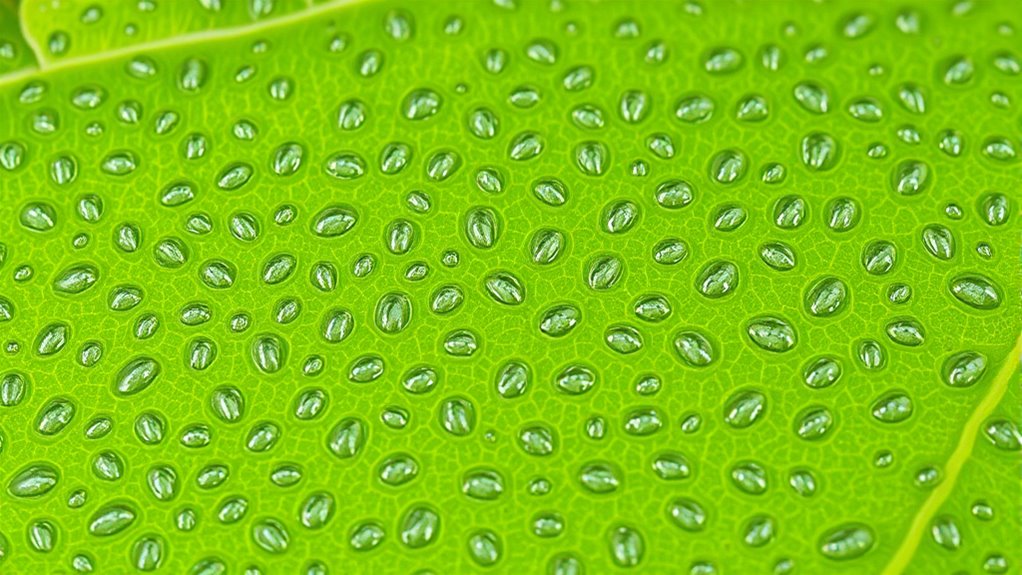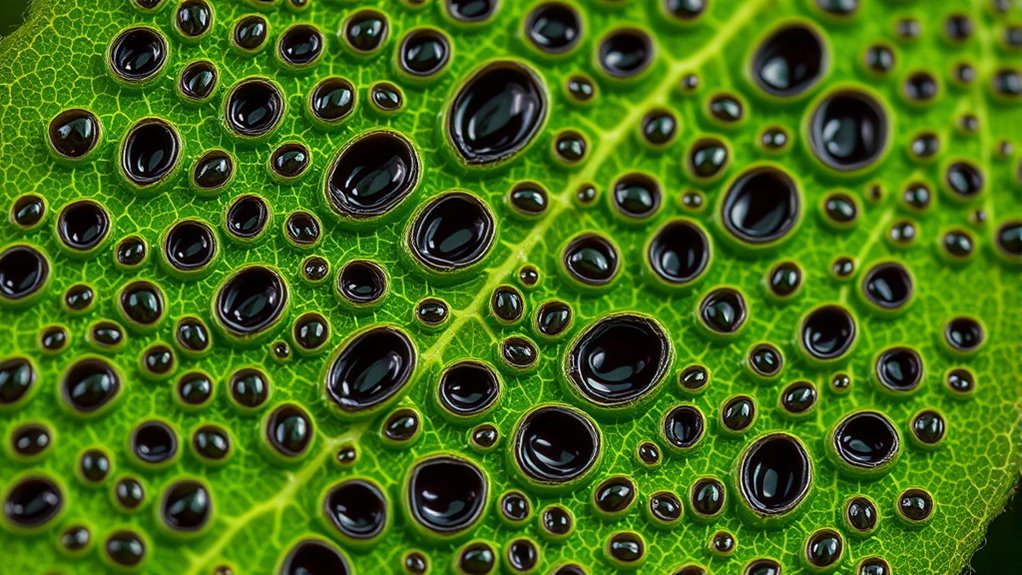Stomata are tiny pores on your plant’s leaves that act as gatekeepers, controlling how gases and water move in and out. They open to let in carbon dioxide for photosynthesis and close to prevent water loss during dry conditions. Guard cells detect signals like light and humidity to change shape quickly, regulating stomatal opening and closing. If you want to discover more about these essential plant secrets, keep exploring how they truly influence your plant’s health and survival.
Key Takeaways
- Stomata are tiny leaf pores regulated by guard cells that control gas exchange and water loss.
- Opening stomata allows CO₂ intake for photosynthesis but also causes water vapor loss.
- Guard cells respond to environmental signals like light and humidity to open or close stomata.
- Closing stomata helps plants conserve water during stress, balancing growth and survival.
- Stomatal behavior influences plant health, growth, and resistance to environmental challenges.

Have you ever wondered how plants breathe? It’s a fascinating process that happens through tiny openings on their leaves called stomata. These small pores might seem insignificant, but they play a essential role in a plant’s survival. When you look closely at a leaf, you’ll notice numerous stomata scattered across its surface. Each stoma is surrounded by specialized guard cells that control whether the pore opens or closes. This delicate mechanism allows the plant to regulate gas exchange efficiently.
Plants breathe through tiny stomata on their leaves, regulating gas exchange and water loss efficiently.
When photosynthesis occurs, plants need to take in carbon dioxide from the air. The stomata open up, letting CO₂ flow into the leaf’s internal tissues. At the same time, oxygen, which is a byproduct of photosynthesis, exits through these same pores. But opening stomata isn’t without risks. When they’re open, plants also lose water vapor through a process called transpiration. This water loss can be significant, especially in hot or dry environments. To prevent dehydration, plants have evolved to adjust their stomatal openings based on environmental conditions.
You might notice that on hot, sunny days, some plants close their stomata to conserve water. Conversely, in cooler, more humid weather, they tend to keep them open longer to maximize gas exchange. This dynamic balancing act is essential for maintaining internal water and nutrient levels. Guard cells detect signals like light, humidity, and internal water status, and respond by changing shape—swell to open or shrink to close. This movement is powered by the movement of ions and water into and out of the guard cells, which causes them to bend.
Stomatal control isn’t just about water management. It also influences a plant’s ability to grow and resist diseases. If stomata are open too long, pathogens might invade more easily, so plants have developed immune responses linked to stomatal behavior. Researchers are studying these tiny pores to better understand how plants adapt to changing climates and drought conditions. By learning how stomata open and close, scientists hope to develop crops that use water more efficiently or resist environmental stresses better.
In essence, these small pores are the plant’s gatekeepers—carefully balancing the need for CO₂ intake with water conservation. Their secret lies in their ability to respond dynamically to the environment, ensuring the plant’s health and survival. Interestingly, access to personalized work environments can also influence a plant’s ability to thrive indoors, where light and humidity are controlled. So next time you see a leaf, remember that those tiny stomata hold the key to a plant’s ability to breathe, grow, and thrive.
Frequently Asked Questions
Can Humans Influence Plant Stomatal Behavior Artificially?
Yes, you can influence plant stomatal behavior artificially. By adjusting environmental factors like light, humidity, and carbon dioxide levels, you can encourage stomata to open or close as needed. Additionally, applying specific chemicals or plant hormones can regulate stomatal activity directly. These methods help optimize water use and gas exchange, supporting healthy plant growth and improving resilience to stress.
Are Stomata Present in All Plant Species Worldwide?
No, stomata aren’t present in all plant species worldwide. You’ll find them mainly in vascular plants like ferns, gymnosperms, and angiosperms, which rely on them for gas exchange. However, some plants like liverworts and mosses lack stomata or have very few. These plants adapt differently to their environment, often relying on direct diffusion through their surfaces instead of stomatal regulation.
How Do Environmental Pollutants Affect Stomatal Function?
Environmental pollutants can severely impact your plant’s stomatal function. They often cause stomata to close or malfunction, reducing gas exchange and limiting CO2 intake necessary for photosynthesis. Pollutants like ozone and sulfur dioxide can damage guard cells, leading to dehydration or impaired opening and closing. This stress weakens your plant’s health, making it more susceptible to diseases and stunted growth, ultimately affecting its ability to thrive in polluted environments.
Can Stomata Recover After Prolonged Drought Stress?
Yes, stomata can recover after prolonged drought stress, but it depends on the severity and duration of the drought. If your plant receives adequate water afterward, its stomata may reopen and regain normal function, helping the plant resume gas exchange and photosynthesis. However, severe or prolonged drought might cause irreversible damage, leading to reduced stomatal responsiveness or permanent closure, which can hinder the plant’s recovery efforts.
Do Stomata Have Any Role in Plant Defense Mechanisms?
Stomata are your plant’s tiny soldiers, actively defending against threats! They detect danger and quickly close to block invading pathogens or reduce water loss during stress. By regulating gas exchange and sealing off entry points, they act like a fortress, safeguarding your plant’s health. Without stomata, your plant would be defenseless against pests, diseases, and dehydration—making them essential for survival and resilience in challenging environments.
Conclusion
Now that you know how stomata regulate your plant’s health, it’s clear they’re tiny but mighty. Did you know that a single square inch of leaf surface can contain up to 300 stomata? These tiny pores control water loss and gas exchange, directly impacting your plant’s survival. So next time you see a healthy, thriving plant, remember those microscopic pores are hard at work, making all the difference in its future.











